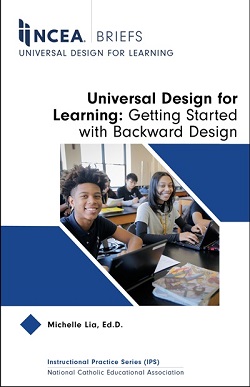
The following blog was contributed by Michelle Lia, Ed.D., Assistant Director for Professional Learning, Andrew M. Greeley Center for Catholic Education, Loyola University Chicago in Illinois.
You have just been hired to teach your dream grade. Hooray! When you are finished signing the paperwork, you are given a link to a Google folder. In it are the written curriculum including a year-long plan for each subject and grade you teach, a unit plan for each item on the year-long plan, folders of materials that the other teachers in your grade also have and use. Okay, let’s do this!
 This would be amazing, wouldn’t it? To walk into a new teaching job equipped with all of those resources. The truth is that we often don’t have access to those resources because they don’t exist yet. This new book by NCEA called Universal Design for Learning: Getting Started with Backward Design is meant to help this. This book shares step-by-step instructions on how to tackle the three parts of Backward Design: year-long plans (sometimes called curriculum maps), unit plans, and lesson plans.
This would be amazing, wouldn’t it? To walk into a new teaching job equipped with all of those resources. The truth is that we often don’t have access to those resources because they don’t exist yet. This new book by NCEA called Universal Design for Learning: Getting Started with Backward Design is meant to help this. This book shares step-by-step instructions on how to tackle the three parts of Backward Design: year-long plans (sometimes called curriculum maps), unit plans, and lesson plans.
Now I know what you might be thinking: but one of the many beauties of teaching in a Catholic school is the freedom to teach my content without the constraints of someone telling me what to teach. Think about when you get a new group of students. They come from three different classes or, in high school, ten different schools. You get ready to teach algebra, English language arts, science, social studies. Some students already know what you are teaching and could present it accurately and fluently. Some have never heard what you are talking about. Wouldn’t it be helpful to know what students learn in previous grade levels? Conversely, isn’t it helpful to know what the next grade level expects so you can guide your students to learn those skills, strategies, and content? In a school, we are all in this together. We all need to know what each other is teaching so we don’t unnecessarily review or leave gaps of knowledge.
Teaching and learning are urgent. We don’t have a lot of time with our students, and we need to focus teaching and learning on the most important skills, strategies, and content. Using the Backward Design framework, or planning with the end in mind, we document these priorities. With no roadmap, we can meander, only pass the landmarks that we like, only stop at the coffee shops we think are best, and we can leave out and miss really crucial stuff.
Backward Design is also a great emissions test, to continue with the road trip analogy. I want to make sure that I am teaching and students are learning the most important skills, strategies, and content each day of each unit throughout the year. Catholic schools promise to teach the whole child. This is more possible when I know the destination.